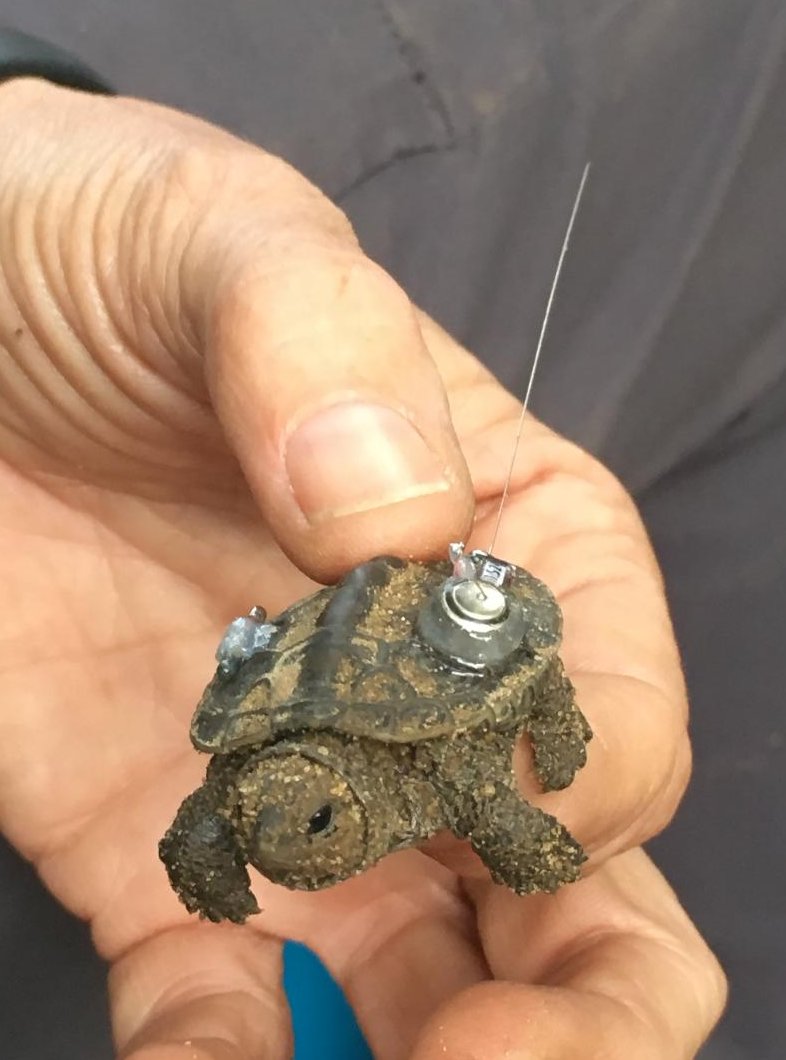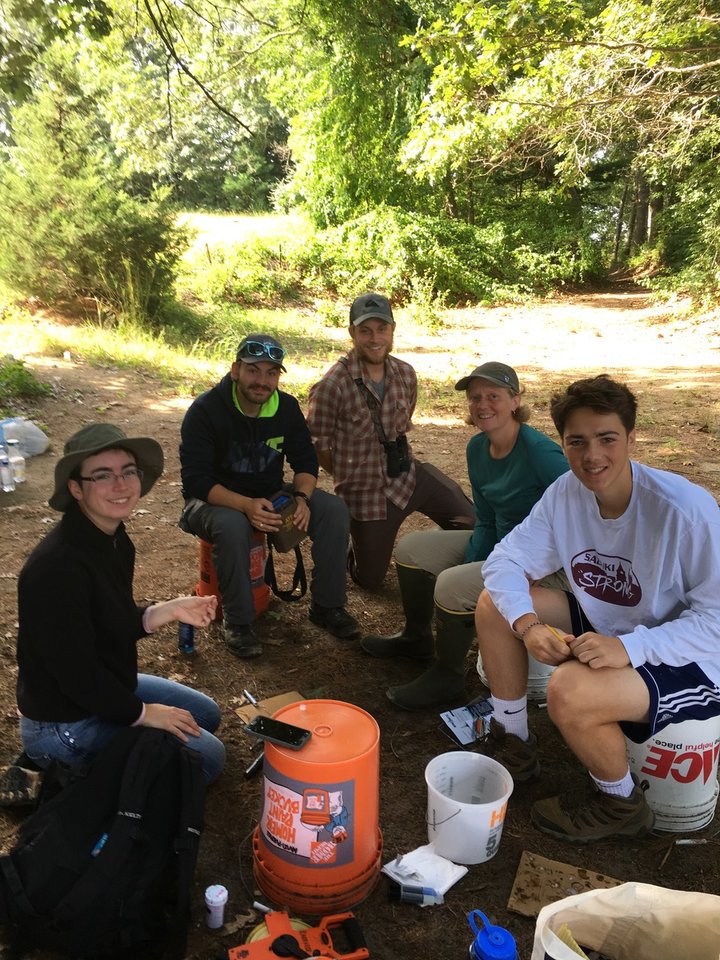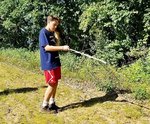Researchers track terrapin hatchlings on Nockum Hill
Objective: Discover where diamondbacks spend their winters
For years people have known that one of the only nesting sites in Rhode Island for diamondback terrapins is at Nockum Hill in Barrington.
But very little information has been gathered about the …
This item is available in full to subscribers.
Please log in to continue |
Register to post eventsIf you'd like to post an event to our calendar, you can create a free account by clicking here. Note that free accounts do not have access to our subscriber-only content. |
Day pass subscribers
Are you a day pass subscriber who needs to log in? Click here to continue.
Researchers track terrapin hatchlings on Nockum Hill
Objective: Discover where diamondbacks spend their winters
For years people have known that one of the only nesting sites in Rhode Island for diamondback terrapins is at Nockum Hill in Barrington.
But very little information has been gathered about the young terrapins after they hatch.
In fact, researchers have been divided about whether the terrapins quickly take to the water at Hundred Acre Cove after hatching or if they bed down under the vegetation at Nockum Hill.
Carolyn Decker is hoping to solve that debate once and for all.
Ms. Decker is pursuing a master's degree in biological and environmental sciences at the University of Rhode Island and recently began work tracking the movements of diamondback terrapin hatchlings at Nockum Hill in Barrington.
"My master's research asks the question: where do hatchling diamondback terrapins overwinter?" Ms. Decker wrote in a recent email to The Barrington Times.
"This is an important question because very little is known about terrapins during their first few years of life. Sometimes, these are called the 'lost years' for turtles."
In an effort to better understand what the tiny terrapins do after they hatch, Ms. Decker and a team of volunteers have been fitting the animals with transmitters — the hatchlings are about as big as an Oreo cookie, weighing between 5 and 9 grams — and tracking their movements. The research project started in August and will continue through the fall, winter and upcoming spring.
"As far as we know, we are the first ones to use this method on hatchling terrapins, though many other studies have been done on this species," Ms. Decker wrote.
"If all goes according to plan, we'll repeat the study for the 2020-2021 year as well. I hope to put all our findings from the two years together for my master's thesis, and ideally publish a scientific paper about our results."
Ms. Decker and the other volunteers, including folks from the Barrington Land Trust and Nockum Hill Management group, are hoping the research will help people form best practices for diamondback terrapin nesting sites in Rhode Island and beyond.
The diamondbacks are included on the state's list of endangered animals and continue to face a series of life-threatening challenges: habitat loss due to climate change, road strikes, predators (coyotes, raccoons, etc.) and human-related dangers.
Earlier this year, Barrington residents voted to approve the expenditure of $1.125 million to purchase a six-acre parcel on Nockum Hill. The land had been owned by a man who planned to build a high-density housing development on the site. The town now plans to preserve the land as open space; the parcel is located a short walk from Rayner Refuge at Nockum Hill where the terrapins nest.
"I believe we have a responsibility to protect this remarkable animal, and help mitigate the risks they face," wrote Ms. Decker.
Dr. Nancy Karraker is an associate professor in the department of natural resources science at the University of Rhode Island. She is serving as Ms. Decker's advisor and is considered an expert in the field of diamondback terrapins.
Dr. Karraker said the research project was developed after one of her former graduate students, Morgan Devlin, undertook a study based on habitat suitability and shoreline access for diamondback terrapins. The study, she said, revealed that Rhode Island has lost at least 20 percent of potential terrapin habitat since 1939, when aerial imagery first became available.
"From our current understanding, only two significant breeding populations of diamondback terrapins remain in Rhode Island, as a result of hundreds of years of coastal development and loss of coastal salt marsh and adjacent sandy areas where terrapins nest. Conservation efforts at these two sites are imperative," Dr. Karraker wrote in a recent email. One of the two sites is Nockum Hill.
The diamondback terrapin population at Nockum Hill has been well-documented over the years, but terrapins' movements after hatching are still a relative mystery. Dr. Karraker said that a research project in Jamaica Bay, NY, which was published in 2012, indicated that most terrapin hatchlings spend their first winters on land, bedding down under vegetation or in the soil. That information ran contrary to the behavior of sea turtle hatchlings which move straight to water.
In an effort to learn even more about the diamondback terrapins hatchlings, Dr. Karraker began volunteering with Barrington residents Charlotte Sornborger, Pete McCalmont and the Nockum Hill management group in 2014. The volunteers are concerned about the terrapins' habitat, including a section of field where the diamondbacks nest — that land is mowed each fall.
"I worried about hatchlings being crushed under the tires of the mower or if they survived that, becoming exposed to the elements or predators," Dr. Karraker wrote.
Each year, starting in the late summer, volunteers begin their work with diamondback terrapins. They place protective metal cages over the tops of nests and record the hatchling numbers. Now, Ms. Decker and others are going one step further and tracking the movements of the newly hatched terrapins.
Early findings
In a recent email to the volunteers, Ms. Decker shared some of the initial findings.
"We had interesting findings with our radio telemetry today," she wrote. "Most hatchlings whose radio tags were attached yesterday (8/29) moved from their nest site to dense vegetation along the edge of the sand pit. Most of these hatchlings were found still in those same spots, or very close by. However, two marched all the way down the slope west of the sand pit and were found in the Phragmites along the edge of the salt marsh. The two that were found in the salt marsh yesterday are apparently still in the marsh, but we couldn't get an accurate read on either of those two. That means four radio-tagged hatchlings have defied our expectations that they would overwinter on land, and instead gone directly to the marsh. I'm so curious to learn if the others will stay up on land, if those in the marsh will move again, or any other possibility!"
Ms. Decker and the others, including Barrington High School student Harry Dunn who is conducting his senior project on the terrapin hatchlings, frequent Nockum Hill each week to monitor the hatchlings' progress.
While using the radio telemetry equipment, volunteers have been able to track the terrapins to areas all across Nockum Hill. Researchers have found that some of the terrapins have buried themselves in the dense vegetation near the sand pit and police firing range. Volunteers have marked the terrapin sites with pink flags "so please be careful and tread lightly!"
As of late August, volunteers had recorded that more than 300 diamondback terrapins had hatched at Nockum Hill. The group tagged 74 hatchlings and attached transmitters and tags to another 20 hatchlings.
Ms. Decker said there have been a number of other people who have helped with the work. She said the researched has received financial support from the University of Rhode Island, the Rhode Island Department of Environmental Management and the Diamondback Terrapin Working Group.
More about the researcher
Carolyn Decker has experience working with diamondback terrapins in Wellfleet, Mass., while she was an undergrad at Wheaton College. "Until very recently, I worked as a wetland biologist doing work such as wetland delineations and habitat assessment. Prior to that, I spent a year as a Thomas J. Watson Fellow studying the intersections of nature conservation and creative writing in Dominica, Botswana, Australia, Tuvalu, and China. Those experiences, coupled with the various field biology projects I did at Wheaton, made me want to delve deeper into scientific research and the conservation world. URI made that dream possible."
Goals for the project
Dr. Nancy Karraker said there are two primary goals for the diamondback terrapin tracking project:
1. "Over two winter periods, Carolyn (Decker) will determine where hatchlings overwinter in the upland, if they do so. That area may then be flagged off and considered restricted to mowing. Vegetation in that restricted area can then be hand pulled in the early summer after the hatchlings have headed for 100 Acre Cove. We will recommend that mowing in that area be restricted on an annual basis."
2. "About one-third to one-half of nests at Nockum Hill are protected with metal wire 'excluders' to keep predators like coyotes out. When the hatchlings emerge, volunteers carry them to vegetation near the edge of the nesting area and release them. However, we currently have no knowledge of where the hatchlings would actually go if left to their own devices. Carolyn is documenting exactly where the hatchlings go immediately after they leave their nest. With this information, we will recommend where volunteers should release hatchlings in the future based on the locations of their nests."













